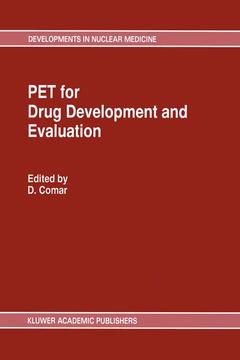PET for Drug Development and Evaluation, Softcover reprint of the original 1st ed. 1995 Developments in Nuclear Medicine Series, Vol. 26
Langue : Anglais
Coordonnateur : Comar D.

Can drug development and evaluation be improved by the use of positron emission tomography (PET)? PET is now well established and many PET centres participate in networks that warrant the quality of their research. PET allows one to follow the effect of a drug on a variety of patients' metabolic parameters. In addition, PET may be used to follow the fate in vivo of a compound, allowing visualisation of its binding to specific receptors and a direct study of the mechanism of drug action in normal and pathological situations.
The book shows the fields in which PET offers new and unique information for the development of drugs (conception, toxicity, pharmacokinetics and metabolism, clinical research, and relations between clinical and biological effects) and evaluates fields in which PET may shorten the development time of drugs.
Audience: Professionals in the pharmaceutical industry in all areas of drug discovery and pharmacology, pre-clinical testing, pharmacokinetics and metabolism, clinical evaluation, registration and regulatory affairs. Government health authority representatives who assess data and documentation on new drug development and radiopharmaceuticals. Academic experts concerned with any of these areas.
The book shows the fields in which PET offers new and unique information for the development of drugs (conception, toxicity, pharmacokinetics and metabolism, clinical research, and relations between clinical and biological effects) and evaluates fields in which PET may shorten the development time of drugs.
Audience: Professionals in the pharmaceutical industry in all areas of drug discovery and pharmacology, pre-clinical testing, pharmacokinetics and metabolism, clinical evaluation, registration and regulatory affairs. Government health authority representatives who assess data and documentation on new drug development and radiopharmaceuticals. Academic experts concerned with any of these areas.
Part one: Introduction. 1. Drug development and positron emission tomography; B. Campbell. 2. Positron emission tomography: Basic principles and potential interest for pharmacological studies; B. Mazoyer. 3. Is PET a tool for drug evaluation? B. Långström, et al. Part two: Psychiatry. 4. PET in neuropsychiatric drug development; L. Farde. 5. Radioligand disposition and metabolism - Key information in early drug development; C. Halldin, et al. 6. PET studies in the early clinical development of a new antipsychotic; J.M. Sitsen, L. Farde. 7. PET in the development of Dopamine D1 antagonists as new potential antipsychotic drugs; C. Foged, et al. 8. Is the 5-HT2-receptor a target for antipsychotic drug action? PET studies on dopamine (D2) and serotonin (5-HT2) receptor occupancy in patients and healthy subjects; S. Nyberg, et al. 9. Preclinical development of a radioligand for the study of central 5-HT1a receptors with PET-[11C]WAY-100635; V.W. Pike, et al. 10. Comparative in vivo and vitro selectivity of zolpidem for omega (Benzodiazepine) modulatory site subtypes; J. Benavides, et al. 11. Do the effects of muscarinic receptor blockade on brain glucose consumption mimic the cortical and subcortical metabolic pattern of Alzheimer's disease in normal volunteers? J. Blin, et al. Part three: Neurology. 12. PET evaluation of drug treatment in ischemic stroke and Alzheimer's disease; W.- D. Heiss. 13. PET imaging of cerebral perfusion and oxygen metabolism in acute ischemic stroke: Implications for management and therapy;J.C. Baron. 14. Pharmacokinetics: Kinetic modelling of MAO inhibitors and D2 antagonists; A. Lammertsma, C.J. Bench. 15. Brain activation under drug treatment; P. Grasby, K.J. Friston. 16. Modifying the progression of Parkinson's disease; P. Morrish, et al. 17. COMT inhibition: Pharmacology of tolcapone and 6- (18F)-Fluoro-L-Dopa (FDOPA) PET results; K. Jorga. 18. Interaction of Lisuride with dopaminergic receptors; B. Mazière, A. Antonini. 19. Lisuride and [C-11]-raclopride interaction at the D2 receptor site; K.L. Leenders. Part four: Cardiology. 20. Drug design in cardiology: the pharmaceutical industry point of view; R. Gradnik. 21. Myocardial receptors and their interaction with cardiovascular drugs; A. Syrota, P. Merlet. 22. The pathophysiological background of cardiovascular diseases and its impact on diagnosis and treatment; P.G. Camici. 23. Effect of cardiotonic drugs on myocardial oxygen consumption and efficiency as assessed by 11C-acetate and PET; L.M. Voipio-Pulkki, et al. 24. Integration of new and classical techniques in drug development. PET application to Propionyl-L-carnitine pharmacokinetic study; A. Longo, et al. Part five: Oncology. 25. The view of the EORTC new drug development office on PET in (pre)clinical trials of anticancer drugs; H.R. Hendriks, J. Wanders. 26. Bottlenecks in anticancer drug discovery and development: In vivo pharmacokinetic and pharmacodynamic issues and the potential role of PET; P. Workman. 27. Radiolabelled anticancer drugs for in vivo pharmacokinetic studies by
Date de parution : 10-2012
Ouvrage de 360 p.
16x24 cm
Thèmes de PET for Drug Development and Evaluation :
© 2024 LAVOISIER S.A.S.



